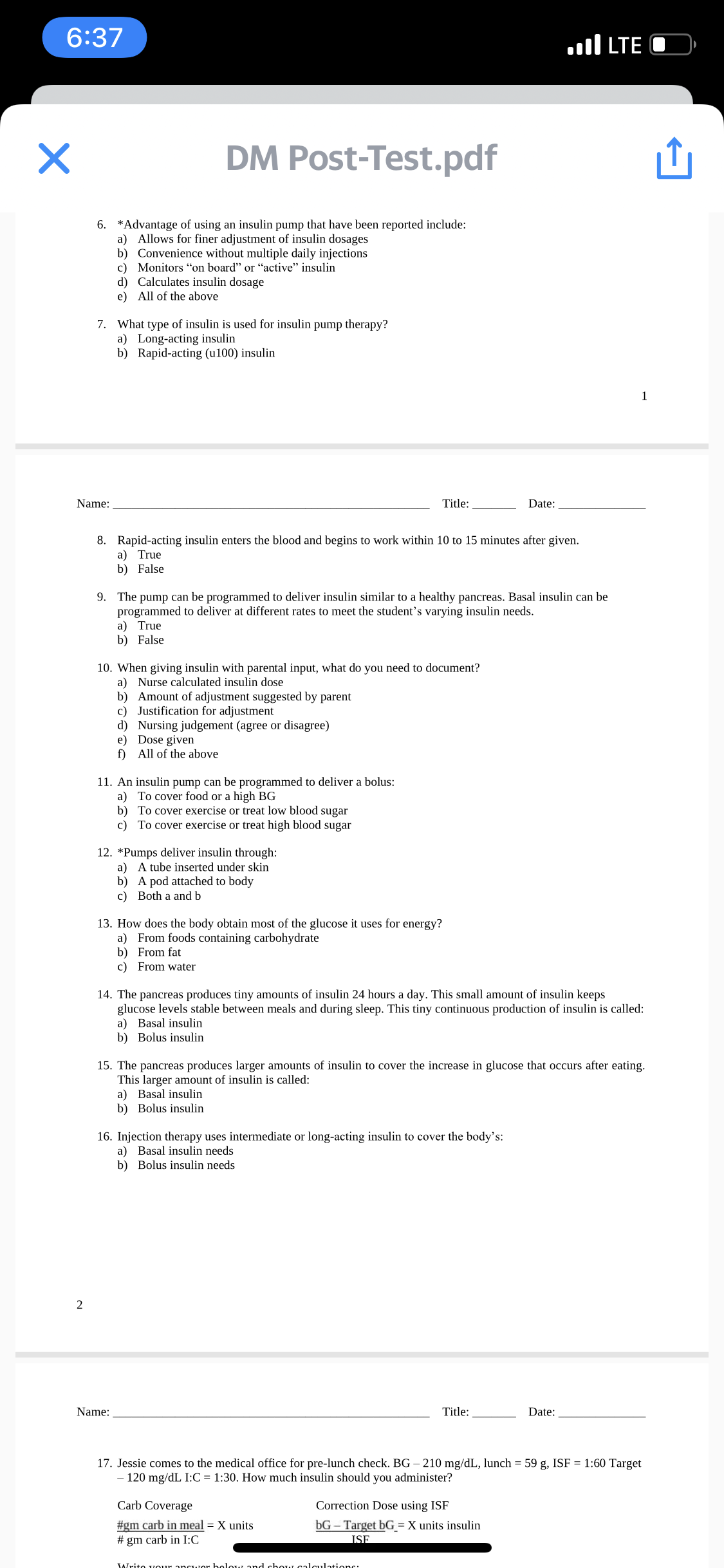7. What type of insulin is used for insulin pump therapy? a) Long-acting insulin b) Rapid-acting (u100) insulin 1 Name: Title: Date: 8. Rapid-acting insulin enters the blood and begins to work within 10 to 15 minutes after given. a) True b) False 9. The pump can be programmed to deliver insulin similar to a healthy pancreas. Basal insulin can be programmed to deliver at different rates to meet the student's varying insulin needs. a) True b) False
7. What type of insulin is used for insulin pump therapy? a) Long-acting insulin b) Rapid-acting (u100) insulin 1 Name: Title: Date: 8. Rapid-acting insulin enters the blood and begins to work within 10 to 15 minutes after given. a) True b) False 9. The pump can be programmed to deliver insulin similar to a healthy pancreas. Basal insulin can be programmed to deliver at different rates to meet the student's varying insulin needs. a) True b) False
Chapter16: Adult And Pediatric Dosages Based On Body Surface Area
Section: Chapter Questions
Problem 5.2P
Related questions
Question
100%
- Please answer 7-16. Thank you

Transcribed Image Text:6:37
TE ןוו.
DM Post-Test.pdf
6. *Advantage of using an insulin pump that have been reported include:
a) Allows for finer adjustment of insulin dosages
b) Convenience without multiple daily injections
c) Monitors "on board" or "active" insulin
d) Calculates insulin dosage
e) All of the above
7. What type of insulin is used for insulin pump therapy?
a) Long-acting insulin
b) Rapid-acting (u100) insulin
1
Name:
Title:
Date:
8. Rapid-acting insulin enters the blood and begins to work within 10 to 15 minutes after given.
a) True
b) False
9. The pump can be programmed to deliver insulin similar to a healthy pancreas. Basal insulin can be
programmed to deliver at different rates to meet the student's varying insulin needs.
a) True
b) False
10. When giving insulin with parental input, what do you need to document?
a) Nurse calculated insulin dose
b) Amount of adjustment suggested by parent
c) Justification for adjustment
d) Nursing judgement (agree or disagree)
e) Dose given
f) All of the above
11. An insulin pump can be programmed to deliver a bolus:
a) To cover food or a high BG
b) To cover exercise or treat low blood sugar
c) To cover exercise or treat high blood sugar
12. *Pumps deliver insulin through:
a) A tube inserted under skin
b) A pod attached to body
c) Both a and b
13. How does the body obtain most of the glucose it uses for energy?
a) From foods containing carbohydrate
b) From fat
c) From water
14. The pancreas produces tiny amounts of insulin 24 hours a day. This small amount of insulin keeps
glucose levels stable between meals and during sleep. This tiny continuous production of insulin is called:
a) Basal insulin
b) Bolus insulin
15. The pancreas produces larger amounts of insulin to cover the increase in glucose that occurs after eating.
This larger amount of insulin is called:
a) Basal insulin
b) Bolus insulin
16. Injection therapy uses intermediate or long-acting insulin to cover the body's:
a) Basal insulin needs
b) Bolus insulin needs
2
Name:
Title:
Date:
17. Jessie comes to the medical office for pre-lunch check. BG – 210 mg/dL, lunch = 59 g, ISF = 1:60 Target
- 120 mg/dL I:C = 1:30. How much insulin should you administer?
Carb Coverage
Correction Dose using ISF
#gm carb in meal = X units
bG – Target bG = X units insulin
# gm carb in I:C
ISF
Write vour ancwor bolow and choN calculations:
Expert Solution
This question has been solved!
Explore an expertly crafted, step-by-step solution for a thorough understanding of key concepts.
This is a popular solution!
Trending now
This is a popular solution!
Step by step
Solved in 2 steps

Recommended textbooks for you


Surgical Tech For Surgical Tech Pos Care
Health & Nutrition
ISBN:
9781337648868
Author:
Association
Publisher:
Cengage



Surgical Tech For Surgical Tech Pos Care
Health & Nutrition
ISBN:
9781337648868
Author:
Association
Publisher:
Cengage


Essentials of Pharmacology for Health Professions
Nursing
ISBN:
9781305441620
Author:
WOODROW
Publisher:
Cengage

